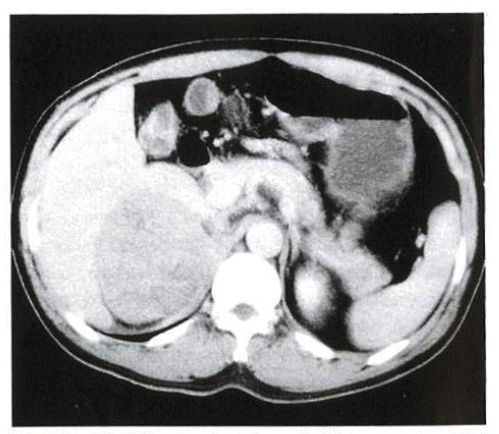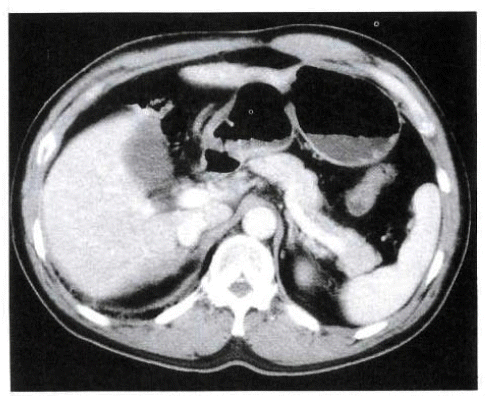A Case of Primary Adrenal Gland Lymphoma
Article information
Abstract
Primary adrenal lymphoma is extremely rare. We describe a case of non-Hodgkin’s lymphoma of diffuse large B-cell type with right adrenal involvement. The patient received chemotherapy and external irradiation and achieved complete remission of the disease. We describe the case of primary adrenal lymphoma with a review of the literature on this unusual neoplasm. Primary adrenal lymphoma should be included in the differential diagnosis of adrenal mass.
INTRODUCTION
Involvement of the adrenal gland by disseminated non-Hodgkin’s lymphoma is found in up to 25% of patients with lymphoma on postmortem examination1). In contrast, primary adrenal gland lymphoma is extremely rare and only 65 cases have been reported worldwide2).
In Korea, the first case of a primary adrenal gland lymphoma was reported in 1999 by Lee et al.3). We report an additional case of diffuse large B-cell lymphoma arising in the right adrenal gland.
CASE REPORT
A 46-year-old man was admitted to the hospital with a chief complaint of right upper quadrant discomfort of one month duration. His past medical history and family history were not remarkable. He denied any episode of fever, night sweat or weight loss. He denied any bowel habit changes or any urinary symptoms. On admission, vital signs were temperature at 36°c, pulse rate 76/min, respiration rate 20/min, and blood pressure 140/80 mmHg. Physical examination revealed that the patient was a well-developed, well-nourished man in no acute distress. There was no evidence of skin pigmentation, palpable lymphadenopathy and organomegaly. The laboratory evaluation included: hemoglobin 13.7 g/dL, white blood cell count 6,500/uL, and platelet count 247,000/uL. The serum sodium level was 138 mEq/L, potassium 4.2 mEq/L, CO2 content 27.2 mEq/L, and the creatinine level was 1.1 mEq/L. Liver function tests were within normal limits and LDH level was increased to 376 U/L (normal: 60–200 U/L). The serum uric acid level was 138 mEq/L, calcium was 10.4 mg/dL and serum β2-microglobulin was 3 mg/dL. The chest X-ray was normal. Abdominal ultrasonography showed a huge mass in the retroperitoneal area. Abdominal CT scan showed a 10×10×10 cm-sized mass in the right suprarenal area which may have originated from the right adrenal gland (Figure 1). The mass was inhomogeneous and poorly enhanced in arterial and portal phases. Hormonal assay included; renin 1.7 ng/mL, aldosterone 9.7 pg/mL, ACTH 3.8 pg/mL and Cortisol 18.3 μg/ mL. The level of 24-hour urine VMA was 5.57 mg/day (normal range: 2–10 mg/day), metanephrine 37.4 μg/day (normal range: 52–341 μg/day) and free Cortisol 87.7 μg/day (normal range: 20–90 μg/day). Ultrasound-guided, fine-needle aspiration biopsy was performed. Under the diagnosis of diffuse large B-cell lymphoma, an exploratory laparotomy was performed. Operative findings revealed a well-encapsulated mass above the right kidney, which was firm and measured about 10×10×8 cm in size. There was no metastatic disease within the abdomen, however, only wedge resection was performed due to the adhesion to the IVC. Histologic findings showed diffuse infiltration of large non-cleaved and cleaved neoplastic lymphocytes with one or several nucleoli. The cytoplasm was clear or amphophilic and moderate in amount (Figure 2). Mitotic figures were frequent. Neoplastic lymphocytes were positive for B-cell markers (L20, and MB-2) and negative for T-cell markers (L45RO, and L43) (Figure 3).

Axial CT scan showed a well-defined 10×10×10 cm-sized mass with homogeneous attenuation in the right suprarenal area.

Diffuse infiltration of atypical large lymphocytes having oval to round or irregular cleaved vesicular nuclei, conspicuous one or several nucleoli and frequent mitotic figures (Hematoxylin & eosin stain, ×400).
Therefore, a diagnosis of diffuse large B-cell lymphoma was made. Chest CT did not show any abnormality and bone marrow aspiration and biopsy revealed no evidence of involvement by lymphoma. The patient received total 8 cycles of CHOP chemotherapy. Follow-up CT scan showed a 3×2.5 cm sized ill defined, low attenuated mass in the right suprarenal area, suggesting a remaining mass (Figure 4). The patient received external irradiation with a total tumor dose of 4,000 rad over 4 weeks to the tumor-bearing area andfollow-up CT scan demonstrated focal thickening of the right diaphragmatic crus area at the level of the upper margin of the right kidney (Figure 5). The patient has been followed up at our outpatient department for the past two years without evidence of recurrence.

Axial CT scan showed a 3×2.5 cm-sized, ill defined, low-attenuated mass in the right suprarenal area.
DISCUSSION
Primary malignant lymphoma of the adrenal gland is extremely rare and is presumed to originate from the hematopoietic tissue inherent to the adrenal gland4).
Primary adrenal lymphoma more commonly affects older men with a median age of 68 and has a male-to-female ratio of 2.2 to 12). Affected patients may manifest with adrenocortical insufficiency (36% of cases), even when the neoplasm is small in size, and some as Addisonian crisis5–7). Other presenting symptoms include fever (46%), weight loss (24%) and abdominal pain (26%)2). Bilateral primary adrenal lymphoma (70%) appears to predominate over the unilateral counterpart2). Most cases are discovered incidentally on abdominal ultrasound and CT8). There is no pathognomonic appearance on CT or US to indicate lymphomatous involvement of the adrenal gland9). Although the sonographic appearance may vary from anechoic or hyperechoic to mixed hypoechoic and hyperechoic lesions, the most common is the hypoechoic variety10). On CT, primary adrenal lymphoma tends to appear as complex masses with variable fluid contents4). However, a few cases also showed homogeneous density11). Frederick et al.4) reported a case of primary adrenal lymphoma with CT appearance of a cystic mass containing mural calcification. In contrast, a secondary adrenal lymphoma most commonly appears as a solid homogeneous mass of soft tissue density distorting the adrenal shape and shows contrast enhancement11). The diagnosis can be confirmed by image-guided percutaneous biopsy of the adrenal gland. This procedure should not be performed until endocrine evaluation has been completed12). Adrenal aspiration is a sensitive and safe method for diagnosing metastasis to the adrenal gland, adrenal lymphoma, and an infectious process13). Over 90% of primary adrenal lymphoma are of B-cell lineage and over 80% are of diffuse large-cell type8). The prognosis of primary adrenal lymphoma is very poor, with a duration of survival ranging from 3 days to 26 months2). There was one case report of long-term survival for 8 years following surgery and adjuvant radiation therapy8). Indicators of a poor prognosis are an advanced age, a large tumor, adrenal insufficiency at the time of presentation which indicates extensive adrenal destruction, and a high level of serum lactate dehydrogenase12). In conclusion, primary adrenal lymphoma should be included in the differential diagnosis of a retroperitoneal mass. Early diagnosis and intervention may dramatically affect the clinical outcome.

